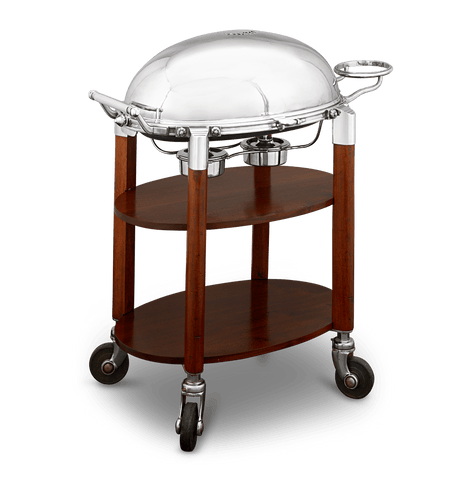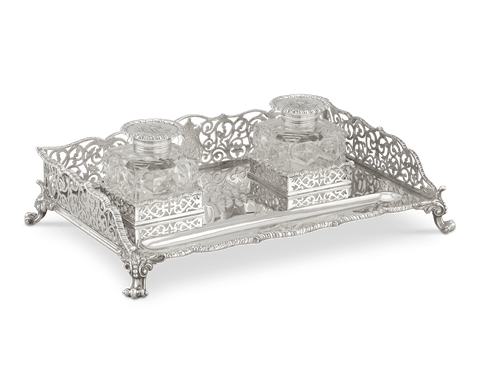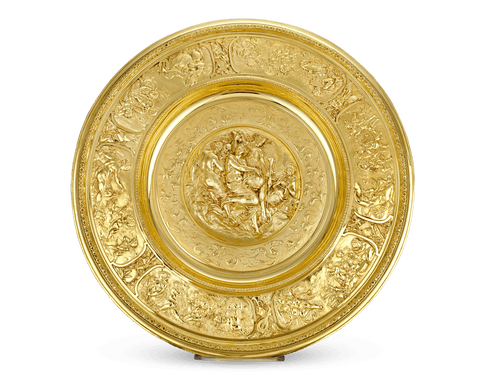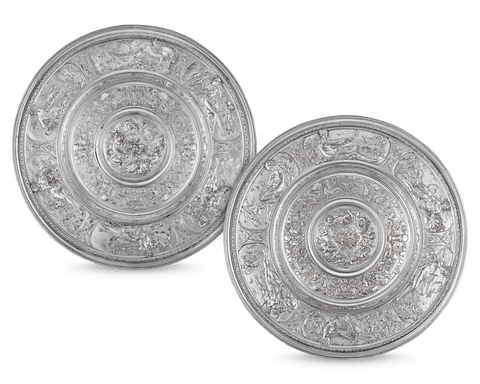Artists & Artisans
Elkington & Co.
Introduction
Elkington & Co. stands as a titan in the world of silverware and electroplating, revolutionizing the industry by perfecting the art of electroplating techniques with silver and gold. Founded in 1840 by George Richards Elkington and his cousin, Henry Elkington, this British company transformed ordinary metals into extraordinary works of art, influencing both the technological and aesthetic landscapes of the 19th century. Their mastery over new electrochemical processes not only marked them as pioneers but also showcased their versatility through decades of artistic and commercial evolution.Background
George Richards Elkington was born in 1801 in Birmingham, England, a city renowned for its vibrant metalworking industry. From a young age, George was immersed in the world of manufacturing and innovation, which was teeming with the industrial fervor of the early 19th century. His early exposure to metalwork and his apprenticeship under a prominent silversmith laid the foundational skills necessary for his future. The inspiration to innovate within the metal industry likely stemmed from witnessing the limitations of traditional silver-making techniques combined with the scientific advancements of the age.
The Foundational Years
Initially, Elkington & Co. focused on perfecting the electroplating process, which George had patented in 1840 after licensing the technology from John Wright, a Birmingham surgeon who discovered that potassium cyanide was a suitable electrolyte for gold and silver electroplating. The defining characteristics of this era were the luxurious quality and durability of its silver-plated goods, which were unprecedented at the time. Influenced by the burgeoning industrial capabilities and the Victorian era’s ornamental demands, Elkington’s key works included elaborate presentation works and tableware, which adorned the dining rooms of the elite.Between 1851 and 1875, Elkington & Co. began exporting their wares, displaying at international exhibitions, such as the Great London Exhibition of 1851, and establishing a global reputation. Their style evolved from purely functional to highly ornamental, incorporating diverse artistic influences ranging from Rococo to Renaissance revival. Key works from this period included the magnificent candelabra presented to Emperor Napoleon III and the elaborate trophy for the 1872 Wanderers Football Club, a triumph of their craftsmanship and artistic expression.
How Electroplating Works:
Electroplating uses electrical current to reduce dissolved metal cations so that they form a coherent metal coating on an electrode. The process Elkington & Co. developed involves several key steps:
Preparation of the Base Metal:
The object to be plated, such as a piece of cutlery or jewelry, is thoroughly cleaned to remove all oils, dirt, and oxidation. This usually involves a series of chemical baths that prepare the surface to receive the silver coating.
Making the Electrolyte:
The electrolyte is a solution of silver cyanide, AgCN, in potassium cyanide, KCN. The KCN acts as a solvent for the silver cyanide and also stabilizes the silver in the solution by forming a complex ion.
Setup of the Electroplating Apparatus:
The object to be plated is submerged in the electrolyte solution. It is connected to the negative terminal (cathode) of a power supply, while a bar of pure silver is connected to the positive terminal (anode).
The Electroplating Operation:
When the power supply is turned on, silver ions in the solution gain electrons from the cathode and are reduced to metallic silver, which coats the object. Simultaneously, at the anode, the silver bar loses electrons and dissolves into the solution, thereby maintaining the concentration of silver in the electrolyte.
Finishing the Product:
After a sufficient thickness of silver has been deposited, the power is turned off, and the object is removed from the bath. It is then rinsed, polished and sometimes burnished to enhance its luster and ensure an even coat of silver.
Refinements and Innovations
Under the leadership of George Richards Elkington, the company made several refinements to the electroplating process that increased the quality and durability of their products. These include:
- Temperature Control: By maintaining the electrolyte solution at a constant temperature, Elkington & Co. were able to produce a more uniform and finer grain of silver coating.
- Agitation of the Electrolyte: Agitating the solution helped to distribute the silver ions evenly, preventing the formation of rough or patchy plating.
- Use of Rotating Electrodes: Rotating the item being plated allowed for even coverage of the silver, particularly important for complex shapes and hollow objects.
Later Life & Legacy
By the late 19th century, Elkington & Co. had set standards for electroplated silverware that many sought to emulate but could rarely match. The visual themes during this phase reflected a return to neoclassical ideals and simpler aesthetic forms, focusing on symmetry and light rather than ornamentation. Their influence was solidified through the establishment of guidelines and standards for electroplating—a legacy that impacted the industry profoundly.
George Richards Elkington passed away in 1865, but his legacy was carried forward by subsequent generations and his well-established company. The later works of Elkington & Co. include the service created for the Titanic and items specially made for the British Royal Family. Today Elkington’s works are held in some of the world’s most important museums, such as the Metropolitan Museum of Art, the Victoria & Albert Museum and the British Museum.
Artists & Artisans
Elkington & Co.
Introduction
Elkington & Co. stands as a titan in the world of silverware and electroplating, revolutionizing the industry by perfecting the art of electroplating techniques with silver and gold. Founded in 1840 by George Richards Elkington and his cousin, Henry Elkington, this British company transformed ordinary metals into extraordinary works of art, influencing both the technological and aesthetic landscapes of the 19th century. Their mastery over new electrochemical processes not only marked them as pioneers but also showcased their versatility through decades of artistic and commercial evolution.Background
George Richards Elkington was born in 1801 in Birmingham, England, a city renowned for its vibrant metalworking industry. From a young age, George was immersed in the world of manufacturing and innovation, which was teeming with the industrial fervor of the early 19th century. His early exposure to metalwork and his apprenticeship under a prominent silversmith laid the foundational skills necessary for his future. The inspiration to innovate within the metal industry likely stemmed from witnessing the limitations of traditional silver-making techniques combined with the scientific advancements of the age.
The Foundational Years
Initially, Elkington & Co. focused on perfecting the electroplating process, which George had patented in 1840 after licensing the technology from John Wright, a Birmingham surgeon who discovered that potassium cyanide was a suitable electrolyte for gold and silver electroplating. The defining characteristics of this era were the luxurious quality and durability of its silver-plated goods, which were unprecedented at the time. Influenced by the burgeoning industrial capabilities and the Victorian era’s ornamental demands, Elkington’s key works included elaborate presentation works and tableware, which adorned the dining rooms of the elite.Between 1851 and 1875, Elkington & Co. began exporting their wares, displaying at international exhibitions, such as the Great London Exhibition of 1851, and establishing a global reputation. Their style evolved from purely functional to highly ornamental, incorporating diverse artistic influences ranging from Rococo to Renaissance revival. Key works from this period included the magnificent candelabra presented to Emperor Napoleon III and the elaborate trophy for the 1872 Wanderers Football Club, a triumph of their craftsmanship and artistic expression.
How Electroplating Works:
Electroplating uses electrical current to reduce dissolved metal cations so that they form a coherent metal coating on an electrode. The process Elkington & Co. developed involves several key steps:
Preparation of the Base Metal:
The object to be plated, such as a piece of cutlery or jewelry, is thoroughly cleaned to remove all oils, dirt, and oxidation. This usually involves a series of chemical baths that prepare the surface to receive the silver coating.
Making the Electrolyte:
The electrolyte is a solution of silver cyanide, AgCN, in potassium cyanide, KCN. The KCN acts as a solvent for the silver cyanide and also stabilizes the silver in the solution by forming a complex ion.
Setup of the Electroplating Apparatus:
The object to be plated is submerged in the electrolyte solution. It is connected to the negative terminal (cathode) of a power supply, while a bar of pure silver is connected to the positive terminal (anode).
The Electroplating Operation:
When the power supply is turned on, silver ions in the solution gain electrons from the cathode and are reduced to metallic silver, which coats the object. Simultaneously, at the anode, the silver bar loses electrons and dissolves into the solution, thereby maintaining the concentration of silver in the electrolyte.
Finishing the Product:
After a sufficient thickness of silver has been deposited, the power is turned off, and the object is removed from the bath. It is then rinsed, polished and sometimes burnished to enhance its luster and ensure an even coat of silver.
Refinements and Innovations
Under the leadership of George Richards Elkington, the company made several refinements to the electroplating process that increased the quality and durability of their products. These include:
- Temperature Control: By maintaining the electrolyte solution at a constant temperature, Elkington & Co. were able to produce a more uniform and finer grain of silver coating.
- Agitation of the Electrolyte: Agitating the solution helped to distribute the silver ions evenly, preventing the formation of rough or patchy plating.
- Use of Rotating Electrodes: Rotating the item being plated allowed for even coverage of the silver, particularly important for complex shapes and hollow objects.
Later Life & Legacy
By the late 19th century, Elkington & Co. had set standards for electroplated silverware that many sought to emulate but could rarely match. The visual themes during this phase reflected a return to neoclassical ideals and simpler aesthetic forms, focusing on symmetry and light rather than ornamentation. Their influence was solidified through the establishment of guidelines and standards for electroplating—a legacy that impacted the industry profoundly.
George Richards Elkington passed away in 1865, but his legacy was carried forward by subsequent generations and his well-established company. The later works of Elkington & Co. include the service created for the Titanic and items specially made for the British Royal Family. Today Elkington’s works are held in some of the world’s most important museums, such as the Metropolitan Museum of Art, the Victoria & Albert Museum and the British Museum.







